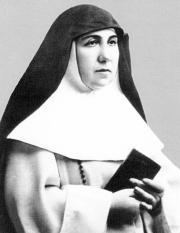Florentina Nicol y Goñi was born on March 14, 1868 in Tafalla, Navarre, Spain, the youngest of four daughters. Her father Juan ran a farm-supply shop, and her mother Águeda was a homemaker who died when Florentina was around four years old.
Like many women who made a name for themselves in religious life throughout history, Florentina was greatly influenced by religious sisters from early childhood. In fact, her father’s cousin was a Carmelite sister who brought two of Florentina’s sisters to her convent to educate them. Those two girls became Carmelite nuns themselves.
When she was 13, Juan enrolled Florentina in a boarding school run by cloistered sisters of the Third Order of St. Dominic. There, in addition to academics, she learned about religious life. At the age of fifteen, however, her father and stepmother brought her home, as they thought she did not need more education.
Several months later, Florentina had her father take her back to the Carmelite convent in Huesca where her sisters were nuns, and there she entered the novitiate. In religious life, she had the name Mary Ascension of the Sacred Heart. For the next 27 years, she served as a teacher.
In 1913, however, the anti-clerical Spanish government expelled the sisters, ending their teaching careers in Spain. After discerning alternate ways to serve God by serving others, the sisters explored the idea of becoming foreign missionaries in the Americas or in the Philippines.
Fortunately, a Dominican friar named Ramón Zubieta contacted the sisters. He had been a missionary priest in the Philippines, and he was now on his way to Rome to be consecrated a bishop. Then, he was going to be the Apostolic Vicar for a new vicariate in Peru. He asked the sisters to come to help him, and five of them volunteered to become missionaries. Sr. Ascensión became the leader of the group.
The group of sisters arrived in Peru in December of 1913 and lived in Lima in a Dominican convent. After a two-year period of acclimation, they took off for their mission in an Amazon village situated between two large rivers.
Within days, the sisters began teaching the girls of the region and began to build a school. Soon, indigenous girls from the Baraya tribe came to the school. Though the white plantation workers did not like the indigenous students to be in the school, Mother Ascensión and the other sisters insisted they be welcome.
Soon, the sisters found that many of the people were coming to them for nursing and medical services, so the sisters added those ministries into their vision.
In 1917, the Catholic Church established a new Code of Canon Law that impinged on the life of religious communities. As a result, the Master of the Dominicans encouraged the sisters to establish a new religious community that was not a cloistered one. So, on October 5, 1918, a new religious community was established and named the Dominican Missionary Sisters of the Rosary. The co-founders were Bishop Ramón Zubieta and Mother Mary Ascensión of the Sacred Heart. Mother Ascensión was the first Prioress General of the new congregation.
In addition to serving in Peru, Mother Ascensión led the congregation to found missions in mainland China and Spain. The community today has missionary sisters in more than twenty nations of the world.
Mother Mary Ascensión died on February 24, 1940. She was beatified on May 15, 2005 with another missionary sister, Marianne Cope, missionary of Molokai, Hawaii. Blessed Mary Ascensión’s feast day is February 24.



